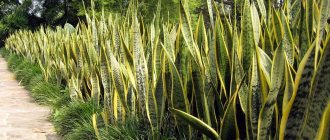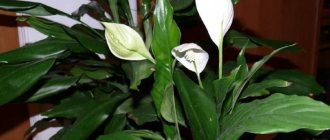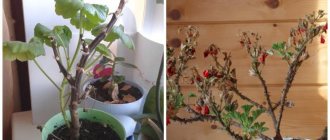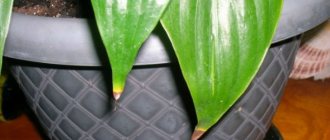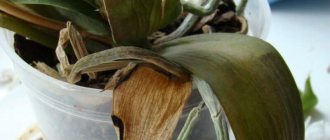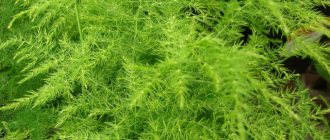The Sansevieria plant officially has another variant of the name - Sansevieria. Our people also call it mother-in-law's tongue and pike's tail. Someone compared this flower to a reptile and called it “snake skin”, “snake braid”, “snake plant”. The British saw in it a “leopard lily”, the Chinese - a “tail of a tiger orchid”, the Turks - a “pasha’s sword”, and the Brazilians even saw a “sword of St. George”. Surely there are many more original names, like “wolf’s tail”, “devil’s tongue” and the like, but this all only indicates that Sansevieria has settled near people for a long time. It has become so domestic and familiar that it is not always noticed, but it is a beautiful plant that brings great benefits to humans in response to minimal care. We will tell you in the article what conditions to create for the plant to grow and reproduce.
Origin and appearance of the plant
Sansevieria (Sansevieria) is a perennial evergreen plant of the asparagus family, a guest from the hot and dry, rocky regions of the tropical and subtropical zone of our planet. The harsh conditions of arid places made it very hardy: it learned to do without moisture for a long time and survive by storing it in the leaves.
The natural growing conditions of Sansevieria made the plant hardy
Under natural conditions, Sansevieria is distributed in India and the Indonesian Pacific Islands, Africa and the island of Madagascar. It also grows in the western hemisphere - in southern Florida.
The leaves of various species can be vertically erect or growing horizontally, green, yellowish or brown in color, with silver, white or yellow specks, stripes, patterns, sometimes bordered by a stripe along the edge of the leaf.
The plant does not have a separate trunk - the leaves grow from the rhizome. When flowering, Sansevieria throws out an arrow with white, sweet-smelling flowers. Mainly reproduces by root shoots.
In former times, fiber was obtained from the leaves of this plant, which was used to make bow strings. Since the beginning of the 20th century, the plant has become a popular house flower. There are more than 60 species and even more varieties derived from them.
The leaves of many indoor sansevieria can reach a height of more than 1 meter.
Ozonator and air washer with prickly tips: benefits and harms of sansevieria
If you remember that sansevieria is inedible, is a little prickly and does not experiment in this regard, the presence of the plant in the room will significantly affect the constant refreshment of the air due to the released oxygen. This is one of the most active room ozonizers, which also actively absorbs and neutralizes such dangerous substances as nitrogen oxide, benzene, formaldehyde and trichlorethylene. These substances are released into the air by various synthetic materials and products, which are sufficient in any apartment.
Sansevieria is used in African folk medicine. According to healers, the smoke produced by burning dry leaves relieves headaches. A decoction treats scabies and relieves itchy skin. And ground fresh leaves disinfect wounds and help with skin diseases.
Sansevieria leaves contain saponin. This substance has an irritating effect on the mucous membranes of the nose, mouth and eyes if the plant juice comes into contact with them. It does not cause irritation upon contact with skin. But in both cases it must be washed off with plenty of water. When the leaves are eaten (which happens - children and pets are careless), saponins cause nausea and vomiting. The sharp and hard tips of the leaves, which can be pricked, pose a certain danger.
It is necessary to limit access to the plant for children and pets.
Video: meet the “mother-in-law’s tongue” flower
How to propagate pike tail
When propagating a stemless plant, regardless of the method chosen, you must adhere to the following safety rules:
- All work on dividing, planting/transplanting a flower should be carried out wearing protective gloves;
- do not allow sansevieria juice to come into contact with the mucous membranes of the eyes;
- Place unused perennial leaves in the trash.
Despite the ability of “mother-in-law’s tongue” to effectively saturate the air with oxygen, it is not recommended to fight negative energy, placing it in places where toddlers sleep and play.
If Sansevieria juice accidentally enters the body, there is a high probability of serious poisoning.
In such a situation, before the ambulance arrives, you need to give the baby or pet activated carbon or sorbent.
Dividing the sheet
The process of propagating Sansevieria by leaf has its own subtleties that must be taken into account to obtain a positive result. This method is of little use for variegated varieties - they lose the pattern on the mother flower.
Variety of species and varieties
Of course, this is a bold attempt to try to list all the varieties and varieties of this amazing plant in a short article. The uniqueness of the hybrids is manifested in the shape and color of the leaves. Stamina remains the same for all species. The original natural species that gave rise to the selection of varieties is Sansevieria three-striped (three-striped) .
Table: natural types of sansevieria
| Species name | Characteristic | Note |
| Sansevieria three-striped |
| The most common type. In room conditions it reaches 1 m in height or more. |
| Sansevieria cylindrica |
| A deep groove is visible on the leaves. |
| Sansevieria pickaxe | Forms rosettes of 2–3 leaves, the color is a calm shade of green with light grayish or greenish spots. The leaves have a red edge. | Some varieties may have entirely reddish or brown leaves. |
| Sansevieria liberia |
| Originating from tropical West Africa, the name is associated with the country of Liberia. |
| Sansevieria graceful, or graceful | Leaves are up to 30 cm long, pointed towards the apex. The color is gray-green, with brownish-beige or light gray transverse stripes. | The leaves form tubes at the ends. |
| Sansevieria duneri |
| Sometimes the number of leaves in a rosette reaches two dozen. |
| Sansevieria hyacinth | The leaves are lanceolate, collected in bunches of 2 to 4 pieces, width from 2–3 to 7 cm, tapering towards the base. The length of the leaves usually does not exceed 50 cm. | The usual flowering time is winter. The flowers are small, with a very pleasant smell. |
| Sansevieria large | The leaves are up to 15 cm wide, close to wide ovals in shape, without a pointed tip. The color is most often intense green with darker transverse stripes. | Originally from the tropics of Africa. It is not one of the tallest, its height is on average 40–60 cm, but due to the width and apparent massiveness of the leaves it gives the impression of being solid and “big”. |
Reproduction
How to propagate mother-in-law's tongue at home? There are two main ways:
- leaf propagation;
- rhizome division.
Leaf
How does mother-in-law's tongue propagate by leaf? It’s not difficult, but this method has a slight drawback regarding varieties with variegated leaves. Young plants obtained from leaves will lose their pattern and will no longer be similar to the mother plant.
Fully matured and developed leaves are used to grow new plants. The leaf is cut (perpendicular to the veins) into several parts from 7 to 15 cm long. It is very important to remember where the top and bottom sides of the leaves are: if you plant the top side of the leaf in the ground, it will not be able . Cut cuttings are not immediately planted in prepared soil. Sometimes individual pieces need to be allowed to dry. This happens in about 2-3 days. And only then can you start planting them for rooting.
moistened sand as soil - this will help reduce the likelihood of cuttings rotting. They are placed one third into the ground and covered with a jar or film. You can find out more about what kind of land is needed for growing sansevieria at home and in open ground here.
Further planting in a permanent place is carried out only after rooting, after 1.5 - 2 months. Read this article for what you need to plant or transplant sansevieria and how to carry out the procedure.
A photo of the propagation of Sansevieria by leaf is presented below:
Vegetative method
A less labor-intensive and faster way to obtain young plants is to propagate the flower by dividing the rhizome. Sansevierias are propagated vegetatively during transplantation.
To carry out division using this method, well-formed bushes are carefully removed from the pot and the rhizome is divided into several parts.
It is important to do this in such a way that each individual part has a growth point . Before planting each plant in its own pot, the cut site should be sprinkled with charcoal powder.
Even if it was not possible to plant the resulting flowers in pots, they can be placed in a jar of water. They can stand there for a long period of time, and this will not affect their condition.
Not many people know that Sansevieria has unusual flowering. How and when this happens, whether the flowers smell, and what diseases and pests can destroy plants - read in our materials.
Important nuances
The result of the work done to propagate sansevieria directly depends on compliance with all the necessary conditions:
- Season. The most suitable season for obtaining new plants is a warm and sunny season - spring (April - May). The optimal temperature for germination should be at 20C. Thanks to this temperature, during leaf propagation, young individuals will take root within 1 - 1.5 months. In the spring, a transplant is carried out, during which the rhizome is divided.
- Lighting. To adapt to new conditions, young plants must be kept in a well-lit place, but at the same time protected from sunlight.
- Watering. When propagating by leaves of Sansevieria, it is recommended to water through a tray , when propagating vegetatively - moderate watering (in no case should the plants be flooded to avoid rotting).
Sansevieria transplant
For normal growth and flowering of the plant, a fairly tight pot is needed. Therefore, transplantation is carried out only as needed, approximately once every 2–3 years.
Transplantation is rarely carried out, only when the roots become cramped in the pot
It should be remembered: the root system of Sansevieria is so powerful that when the entire volume of soil in the pot is occupied by roots, they either tear the pot or begin to bulge upward. This will be a signal that it is time to replant the sansevieria.
What kind of soil and pot are needed?
The soil for sansevieria should be moderately sandy, well permeable to water and air. The classic formula: “leaf soil: turf soil: sand = 1:1:2.” Purchased soil is quite suitable for cacti and succulents . It is advisable to add sand, pebbles and a little clay to it. A prerequisite is the presence of a strong drainage layer at the bottom of the pot (for example, pebbles or expanded clay balls). It should occupy at least 1/4 of the volume of the pot.
The pot needs to be deep, 2–3 cm wider than before. For vertically growing varieties, it is better to take massive clay pots that provide stability for long, heavy leaves.
Important! When transplanting a plant into a new pot, you should tie it to a support while rooting and compacting the soil, since the leaves can overhang and tear the plant out of the ground.
Transshipment with replacement of land
Step by step description:
- Take a pot slightly wider than before, add layers of drainage and then moist soil.
- Water the plant well. After a while, remove it from the old pot, holding it by the leaves at the base.
- Remove old soil from the roots, being careful not to damage them.
- Place the plant in the center of the new container, add soil mixture until the roots are completely covered. Compact it.
- For the next 2 days, keep the plant in the shade and do not water: this will allow the roots to begin to grow into the soil.
Important! When transplanting a plant into a new pot, you should tie it to a support while rooting and compacting the soil, since long and heavy leaves can overwhelm and tear the plant out of the ground.
Home care
Pike tail is one of the most undemanding plants to care for. To make a flower comfortable, you only need to know the basic rules.
One of them is that Sansevieria does not like to be moved from place to place.
Lighting
Sansevieria feels equally good both in a sunny corner and in a shaded one.
But it should be remembered that in the absence of light for a long time, variegated varieties lose their brightness.
It is better to protect the plant from direct rays, as this can cause burns. In winter, artificial supplementary lighting is recommended. In spring and summer, the pike tail can be taken out into the fresh air, but the place is chosen in such a way that raindrops do not fall on the leaves.
Temperature
The flower is completely indifferent to temperature changes; not a single draft will harm sansevieria. In summer, the optimal thermal regime is from +18° to +25°С, in winter +14…+16°С. At air temperatures below +10°, the plant will not die, but will stop growing.
Watering
Like other succulents, it does not tolerate excess moisture. It is enough to water the pike tail once a week in the summer and once a month in the winter. An important point is that you need to carefully ensure that water does not get into the middle of the outlet, as this will lead to rotting.
Top dressing
Even the most unpretentious herbal pets need vitamins, and therefore we must not forget about fertilizers. They feed the mother-in-law's tongue three times during the summer (once a month). At the same time, a 50% solution of mineral fertilizer for cacti is added (with a predominance of the potassium-phosphorus component).
Transplantation and soil
Since the root system of the pike tail does not grow in depth, but to the sides, the pot must be wide and strong enough to withstand the pressure.
It is imperative to make a drainage layer. The ideal soil consists of leaf, turf soil and sand in a ratio of 2:2:1. Young plants are usually replanted once every one and a half to two years, older plants - once every three years. If the procedure is carried out in the spring, then it is combined with dividing the bush.
Proper care - water less?
If we remember the harsh conditions of the natural growth of sansevieria, it becomes clear that this is one of the most unpretentious plants, capable of withstanding significant temperature changes, varying light levels and drought.
Important! The only problem for a plant during care can be excessive watering and water getting into the center of the leaf rosettes (especially in winter).
Nevertheless, there are comfortable, acceptable and unacceptable regimes for keeping sansevieria. In particular:
Reviews from flower growers
The houseplant Sansevieria (Piketail) has been living in my home for about 9 years.
I plucked off a small shoot from my mother-in-law, then we transplanted it into a jar, it took root and began to grow. Over time, the pike tail “demanded” a rather impressive pot, because it began to multiply by leaps and bounds. It became more and more crowded... My husband cannot stand its flowering (he is allergic). It is interesting that such droplets appear on the flowers of this plant. koala2014, Russia, Moscow
https://otzovik.com/review_2025984.html
This is the most unpretentious plant I have ever had.
There was a time when I constantly lived in 2 houses and sometimes did not appear in the apartment where Sansevieria was faithfully waiting for me for several months. All this time, no one watered the plant, and not only did it not bend, it also bloomed constantly. ilek87, Russia, Moscow
https://otzovik.com/review_2025984.html
I took this flower from a friend out of pity.
It stood on her window for several years and slowly just withered away. Then it was flooded - it was standing in water, then there was a drought in the ground. She was about to throw it away, and I picked it up. I changed the pot and soil and planted it, not counting on anything, three leaves. For several months the flower just sat in the ground, and after three or four months three leaves came out of the ground - my joy knew no bounds. Now this flower is two years old. <…> This summer I suddenly saw some dry white leaves on the windowsill. It turns out that my Pike tail is in full bloom. <…> The leaves of the pike tail are very dense, and therefore heavy. I can’t lift this flower pot. In addition to being beautiful, this flower is also useful. This flower is considered the best air purifier. A pike tail is absolutely necessary in a new apartment, in an apartment after renovation or after installing new furniture. The pike tail clears the air of chemicals and paint products. And where there is clean air, immunity is higher and people get sick less. gallin1234, Russia, Moscow
https://otzovik.com/review_1443895.html
Peculiarities of reproduction at different times of the year
Theoretically, Sansevieria can be propagated all year round. However, in the spring it takes root and grows much more readily.
- In the spring. Spring is the most favorable time for propagation of any plant. In March, and sometimes at the end of February, Sansevieria becomes more active. The separated sockets and the children quickly take root in the new place and begin to grow rapidly. The leaves also take root quite easily. In just a few months they can give birth to their babies.
- In summer. Throughout the summer, you can divide the adult sansevieria and place the children. Leaf propagation is best done in early June or late August. In hot weather at temperatures above +28+30 degrees, roots may not form for a long time, and leaves may dry out. It is important to place leaf cuttings and transplanted parts of the plant in a place with diffused light so that they do not get burned.
- In autumn. Starting from October, the plant slows down its growth and reproduces extremely reluctantly due to the slow course of metabolic processes. In autumn it is not recommended to divide sansevieria. You can plant shoots or try to root parts of the leaf in the ground.
Video: caring for one of the most durable indoor flowers
You can often hear the opinion that Sansevieria will not dry out even if it is not watered for six months. But this is a living organism, therefore, it should still be given attention: the more return there will be on the part of the grateful green pet. This plant protects the cleanliness of the air in the house, saturates it with oxygen, and inhibits pathogenic microbes. These properties are now officially recognized by international scientific centers.
- Author: Evgeny Gridnev
Hello! My name is Evgeniy. My age is quite sufficient to have two higher educations and an academic degree, which allowed me to become, be and remain a biologist and ecologist. Rate this article:
- 5
- 4
- 3
- 2
- 1
(8 votes, average: 3.8 out of 5)
Share with your friends!
Rhizome division
Let's look at how you can propagate a plant of the cylindrical variety step by step. Propagation by rhizome division is good because the new plants fully retain their parental qualities. Divide the rhizome in early spring. Do this carefully for two reasons. The first is the threat of breaking long leaves, and the second is the threat of damage to the roots.
